Who doesn’t love sparkling clean windows that allow the sun to illuminate the room? However, achieving that perfect streak-free shine can be quite a challenge. But worry not, for we have compiled the ultimate guide to help you clean windows inside and out like a pro. From choosing the right tools to maintaining that pristine appearance, you’ll soon be the envy of your neighbours with your immaculate windows.
Short Summary
- Choose the right tools and techniques for streak-free window cleaning, such as microfiber cloths, mops and squeegees.
- Prepare windows by removing dust & debris, then select a suitable cleaning solution.
- Maintain clean windows with a regular schedule & prevent streaks/smudges using lint-free materials
Table of Contents
ToggleChoosing the Right Tools for Window Cleaning
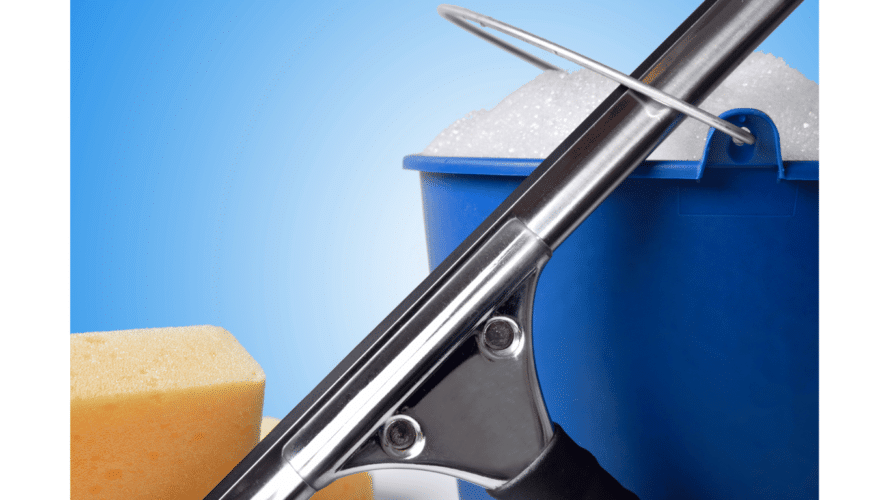
To ensure a spotless and streak-free finish on your windows, it’s essential to use the appropriate tools and cleaning supplies. Using the wrong tools can make cleaning windows harder, leaving streaks, or even damaging the window.
Some vital tools for window cleaning include microfiber cloths, a mop (applicator), squeegees, and extension poles. Let’s dive into these essential tools and learn how they can help you achieve crystal-clear windows.
Mop (Applicator)
A mop or an applicator is a tool used to apply a soap solution to the windows you are about to clean. This absorbent tool holds a lot of water and is the ideal tool to agitate the dirt from the glass.
Squeegees
Squeegees are an essential tool for achieving streak-free windows. Featuring a flat rubber or silicone blade and a handle, squeegees help remove water or cleaning solution from the window surface, providing a professional finish. To use a squeegee effectively, moisten the blade with water or a cleaning solution, then start at the top of the window and draw the squeegee down in a single, smooth stroke.
Wipe the blade clean after each stroke and repeat until the window is clean. Remember to apply gentle pressure and maintain a consistent angle for the best results.
Microfiber Cloth
Microfiber cloths are an indispensable tool for window cleaning due to their lint-free and highly absorbent nature, making them a great alternative to paper towels. The microfiber cloth is excellent for cleaning the small water drips left behind after the window has been squeegeed.
When caring for your microfiber cloth, wash it in a washing machine with a mild detergent and air dry or tumble dry on low heat, avoiding fabric softener and bleach. Say goodbye to lint and streaks with the help of a trusty lint-free cloth, like your microfiber cloth.
Extension Poles
Extension poles, also known as telescoping poles, allow you to reach high or hard-to-reach windows without needing a ladder. You can easily access and clean those difficult-to-reach windows by attaching a squeegee or mop to the end of the pole.
It’s recommended to start at the top of the window and move downwards, using a back-and-forth motion to remove dirt and debris. With an extension pole, no window will be out of reach.
Preparing Windows for Cleaning
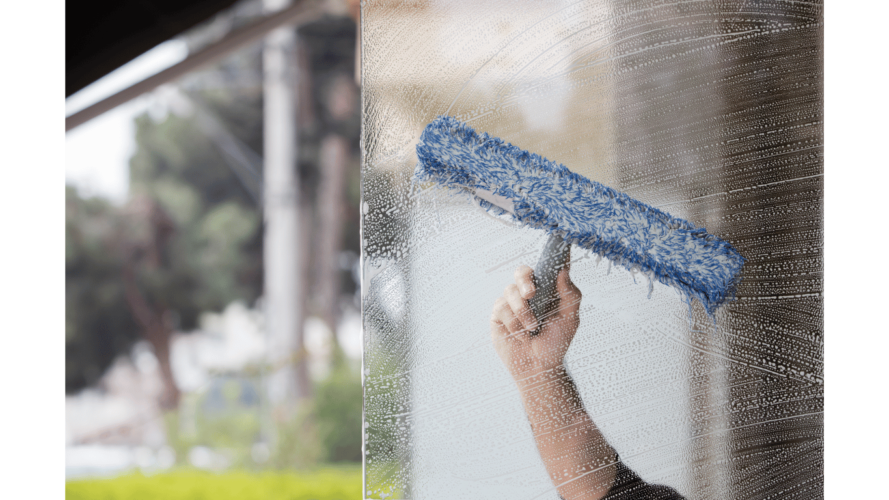
Before diving into the cleaning process, it’s crucial to prepare your windows to ensure the best results properly. Preparing your windows involves removing dust and debris and selecting an appropriate cleaning solution, whether store-bought or DIY.
Let’s explore how to prepare your windows for a thorough cleaning session.
Removing Dust and Debris
To effectively clean your windows, it’s essential to first remove dust and debris from the window sills and frames. Utilize a vacuum with hose attachments to clean these areas before washing the windows.
Additionally, you can use a dry microfiber cloth to wipe the window sills and remove any remaining dust. By taking these preparatory steps, you’ll set the stage for a successful window cleaning session. Most professional window cleaners will use a damp cloth to remove dirt from the window frames and sills before washing windows.
Selecting a Cleaning Solution
Choosing the right glass cleaner for your windows is critical for achieving a streak-free shine. You can choose store-bought cleaning products or create your DIY solution using vinegar, water, and dish soap.
Mix 1/4 cup of white vinegar and 1/2 teaspoon of dish soap in a clean spray bottle. Then, add 2 cups of water. You now have your homemade window cleaner. While store-bought cleaners offer convenience, DIY solutions are usually more budget-friendly and eco-friendly, giving you a safe and effective option for cleaning your windows.
You can also fill a bucket of cold water from the tap and squirt in a few drops of your favourite liquid dish soap. This is my preferred option as a professional window cleaner, but I like to back it up with a spray bottle that I fill with the soapy water I prepared in the bucket.
Interior Window Cleaning Techniques

Now that your windows are ready let’s tackle the inside. Cleaning the interior windows may seem straightforward, but there are some essential techniques to help you achieve that perfect shine.
In this section, you’ll explore different types of windows and how to clean window tracks and sills.
Different Types of Windows
Windows come in various styles, such as single-hung, double-hung, casement, awning, sliding, bay, and picture windows. Each type of window requires a slightly different approach to cleaning. For example, single-hung and double-hung windows can be cleaned by raising the bottom sash and wiping the glass with a window cleaner.
Casement and awning windows can be cleaned by opening the window and wiping the window glass from the inside. Sliding windows can be cleaned by removing the sliding sash and cleaning both sides of the glass.
By understanding the specific requirements of each type of window, you’ll be well-equipped to achieve a thorough cleaning.
Cleaning Window Tracks and Sills
Window tracks and sills often accumulate dirt and debris, which can hinder the proper functioning of your windows. Use a damp cloth and mild detergent to clean window tracks and sills. You can also use a toothbrush or bristle brush to scrub the tracks clean for stubborn dirt.
If you have access to a wet vacuum, use the bottle of detergent mentioned in the previous section to spray into the tracks. With a track brush, you can agitate the dirt and then vacuum up the dirty water leaving the tracks look clean. This is an option many window cleaners use.
By regularly cleaning window tracks and sills, you’ll not only improve the appearance of your windows but also ensure their smooth operation.
Exterior Window Cleaning Methods
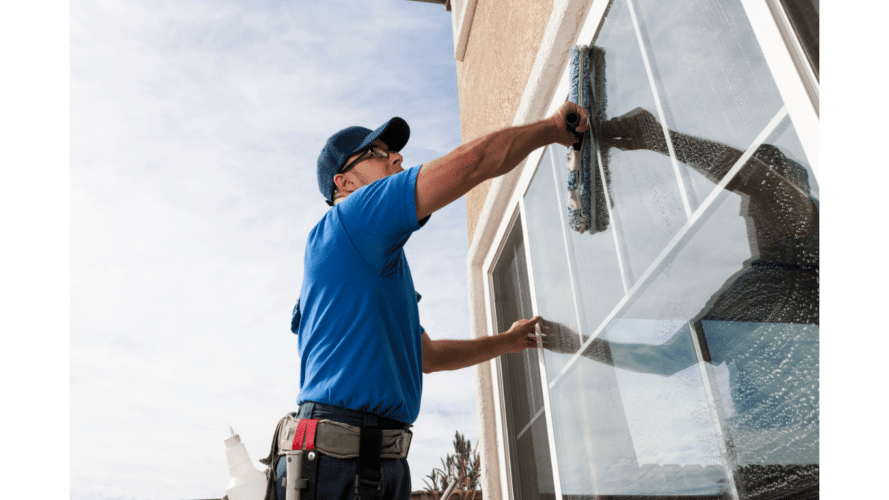
Cleaning exterior windows may seem daunting, but with the right tools and techniques, it can be a breeze. In this section, we’ll explore various methods for cleaning exterior windows, including using a garden hose, telescopic pole, or even a robotic window cleaner.
Using a garden hose is a great way to quickly and easily clean exterior windows. Simply attach the hose to the window and spray away dirt and grime. For tougher stains, you may need to use a brush attachment.
Garden Hose Method
One efficient way to clean your outside windows is by using a garden hose method. This involves using a high-pressure spray nozzle and a solution-dispensing cylinder to clean the windows. You can also attach a container of Windex’s outdoor glass-cleaning solution to your garden hose and spray the windows, followed by rinsing with plain water.
To achieve a streak-free finish, dry the windows with a microfiber cloth after rinsing. With the garden hose method, you can clean your exterior windows quickly and effectively.
Telescopic Pole Technique
The telescopic pole technique is another excellent method for cleaning hard-to-reach exterior windows without the need for a ladder. Attach a brush to the telescopic pole, spray the window with pure water, and use the brush to agitate the dirt. Hold the brush a short distance away from the window and rinse it with the water jets for a clean finish.
This technique allows you to safely and efficiently reach those hard-to-clean windows by incorporating window-washing techniques from the ground.
Robotic Window Cleaner

For a hands-free and efficient cleaning experience, consider investing in a robotic window cleaner. These devices use sensors to identify window boundaries and a cleaning solution to clean the windows. To operate a robotic window cleaner, simply fill the device with a cleaning solution, place it on the window, and press the start button.
With a robotic window cleaner, you can sit back and relax while it cleans all your windows. No more scrubbing and wiping; just press the start button and let the robotic window cleaner do the work for you. Enjoy streak-free, clean windows in no time.
These do clean your dirty windows, but they do come at a cost. They can be time-consuming to set up, and they are expensive. But if you have the time and the money, then go ahead and purchase.
Cleaning Window Screens
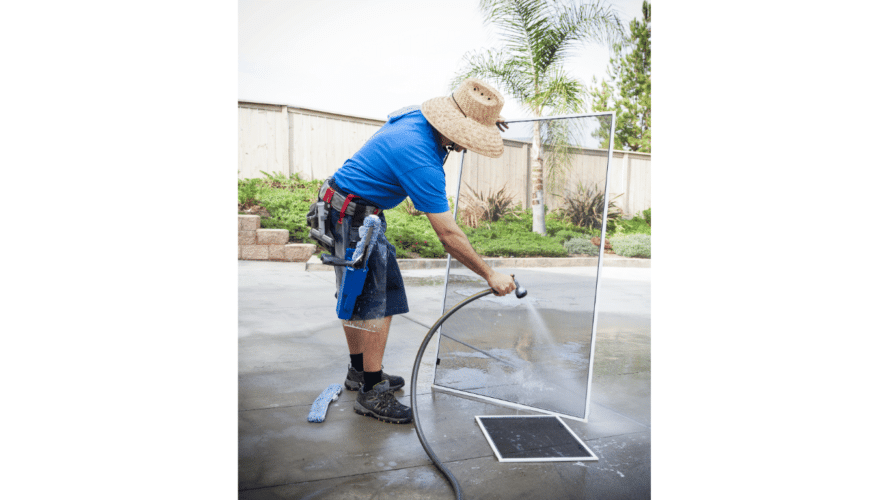
Window screens play a crucial role in keeping insects and debris out while allowing fresh air in. However, they can become dirty and clogged over time, which reduces their effectiveness and contributes to dirty windows.
In this section, we’ll guide you through the process of cleaning window screens by removing, washing, and reattaching them.
Removing Screen
The first step in cleaning a window screen is to remove them carefully to avoid damage and make cleaning easier. To remove a window screen, open the window fully and locate the screen tabs. Press them inward while pulling the screen towards you.
Make sure to keep track of which screen goes where to ensure proper reattachment later on.
Washing Screens
With the screens removed, it’s time to give them a thorough cleaning. Wash the screens using a hose or shower, along with a cleaning solution. Gently scrub the screens with a soft brush or cloth to remove dirt and debris, taking care not to use abrasive brushes or brooms that may damage the screens. Use a hose to rinse off all the dirt and soap.
After washing, leave the screens to dry. Once completely dry, reattach them.
Reattaching Screens
Once the window screen is clean and dry, it’s time to reattach them. Slide the screens back into the window frame and secure them with clips or screws.
By properly cleaning and reattaching your screens, you’ll not only improve the appearance of your windows but also enhance their functionality.
Maintaining Clean Windows

Keeping your windows clean not only improves the aesthetics of your home but also allows more natural light to enter, brightening up your living spaces.
In this section, we’ll discuss how to maintain clean windows by following a regular cleaning schedule and preventing streaks and smudges.
Regular Cleaning Schedule
To keep your windows looking their best, it’s essential to clean them at least twice a year, with outdoor windows potentially requiring more frequent touch-ups due to environmental factors. By keeping a regular cleaning schedule, you’ll ensure that your windows remain clear and allow plenty of sunlight to brighten your home.
Regular window cleaning is an easy way to keep your home looking its best. Not only will it make your windows sparkle, but it will also help to reduce the amount of dirt and dust that accumulates on the glass. Additionally, it will help to prevent the build-up.
Preventing Streaks and Smudges
Preventing streaks and smudges during window cleaning can be achieved by using the right tools and techniques. Drying windows from top to bottom and using lint-free materials such as microfiber cloths will help ensure a streak-free shine.
By following these tips and maintaining a regular cleaning schedule, you’ll enjoy crystal-clear windows year-round.
Summary
In conclusion, achieving streak-free windows doesn’t have to be a daunting task. By choosing the right tools, preparing your windows for cleaning, and following proper techniques for both interior and exterior windows, you can enjoy spotless windows that allow natural light to flood your living spaces. Don’t forget to maintain a regular cleaning schedule to keep your windows looking their best and prevent the build-up of dirt and debris. Happy Cleaning!
Frequently Asked Questions
What is the best thing to clean windows with?
The best thing to clean windows with is a mixture of dish soap and cold water. This proven method has been used for decades and works well in cutting through dirt, debris, and grime on glass surfaces.
For spotless windows, use this simple solution to get the job done quickly and effectively.
What is the best way to clean outside windows?
For a thorough cleaning, use a mixture of water and soap. Wet a mop or cloth in the solution and wipe down the window’s surface. To dry the windows, finish with a rubber squeegee, wiping in straight motions from top to bottom.
This method is the best way to get streak-free windows for a spotless finish.
What tools do I need for window cleaning?
In order to properly clean windows, you’ll need a few tools: cloths, squeegees, mops and extension poles.
These tools will help you to get a streak-free shine on your windows!
How often should I clean my windows?
For the best results, it’s advisable to clean your windows at least every six months in order to keep them looking great and free from dirt and dust.
What is the best way to prevent streaks and smudges when cleaning windows?
For streak-free windows, use a soft microfiber cloth and gentle window cleaning solution, and clean from top to bottom.

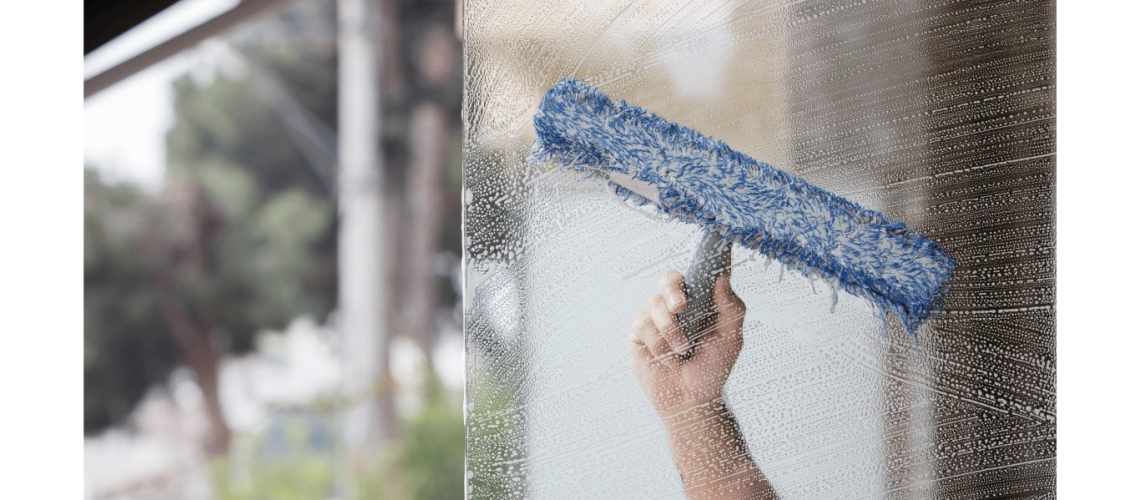
1 thought on “Get Streak-Free Windows: Expert Tips for Cleaning Windows Inside and Out”
Thankyou for sharing. It is really helpful. You can also try the new Glass Cleaning Services for cleaner and brighter windows.